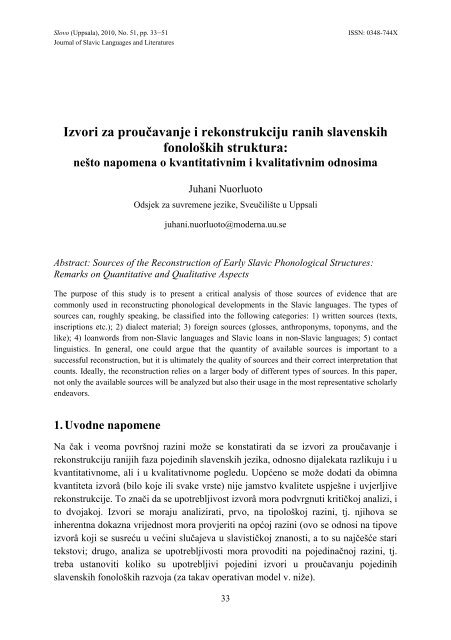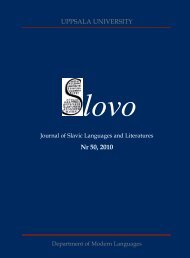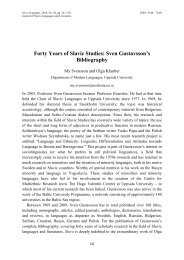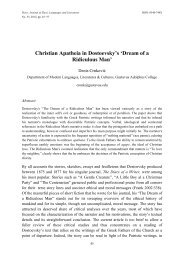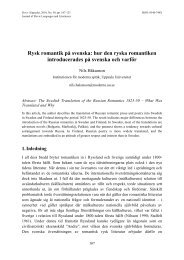UPPSALA UNIVERSITY - Index of - Uppsala universitet
UPPSALA UNIVERSITY - Index of - Uppsala universitet
UPPSALA UNIVERSITY - Index of - Uppsala universitet
- No tags were found...
You also want an ePaper? Increase the reach of your titles
YUMPU automatically turns print PDFs into web optimized ePapers that Google loves.
Slovo (<strong>Uppsala</strong>), 2010, No. 51, pp. 33–51 ISSN: 0348-744XJournal <strong>of</strong> Slavic Languages and LiteraturesIzvori za proučavanje i rekonstrukciju ranih slavenskihfonoloških struktura:nešto napomena o kvantitativnim i kvalitativnim odnosimaJuhani NuorluotoOdsjek za suvremene jezike, Sveuĉilište u Uppsalijuhani.nuorluoto@moderna.uu.seAbstract: Sources <strong>of</strong> the Reconstruction <strong>of</strong> Early Slavic Phonological Structures:Remarks on Quantitative and Qualitative AspectsThe purpose <strong>of</strong> this study is to present a critical analysis <strong>of</strong> those sources <strong>of</strong> evidence that arecommonly used in reconstructing phonological developments in the Slavic languages. The types <strong>of</strong>sources can, roughly speaking, be classified into the following categories: 1) written sources (texts,inscriptions etc.); 2) dialect material; 3) foreign sources (glosses, anthroponyms, toponyms, and thelike); 4) loanwords from non-Slavic languages and Slavic loans in non-Slavic languages; 5) contactlinguistics. In general, one could argue that the quantity <strong>of</strong> available sources is important to asuccessful reconstruction, but it is ultimately the quality <strong>of</strong> sources and their correct interpretation thatcounts. Ideally, the reconstruction relies on a larger body <strong>of</strong> different types <strong>of</strong> sources. In this paper,not only the available sources will be analyzed but also their usage in the most representative scholarlyendeavors.1. Uvodne napomeneNa ĉak i veoma površnoj razini može se konstatirati da se izvori za prouĉavanje irekonstrukciju ranijih faza pojedinih slavenskih jezika, odnosno dijalekata razlikuju i ukvantitativnome, ali i u kvalitativnome pogledu. Uopćeno se može dodati da obimnakvantiteta izvorâ (bilo koje ili svake vrste) nije jamstvo kvalitete uspješne i uvjerljiverekonstrukcije. To znaĉi da se upotrebljivost izvorâ mora podvrgnuti kritiĉkoj analizi, ito dvojakoj. Izvori se moraju analizirati, prvo, na tipološkoj razini, tj. njihova seinherentna dokazna vrijednost mora provjeriti na općoj razini (ovo se odnosi na tipoveizvorâ koji se susreću u većini sluĉajeva u slavistiĉkoj znanosti, a to su najĉešće staritekstovi; drugo, analiza se upotrebljivosti mora provoditi na pojedinaĉnoj razini, tj.treba ustanoviti koliko su upotrebljivi pojedini izvori u prouĉavanju pojedinihslavenskih fonoloških razvoja (za takav operativan model v. niže).33


